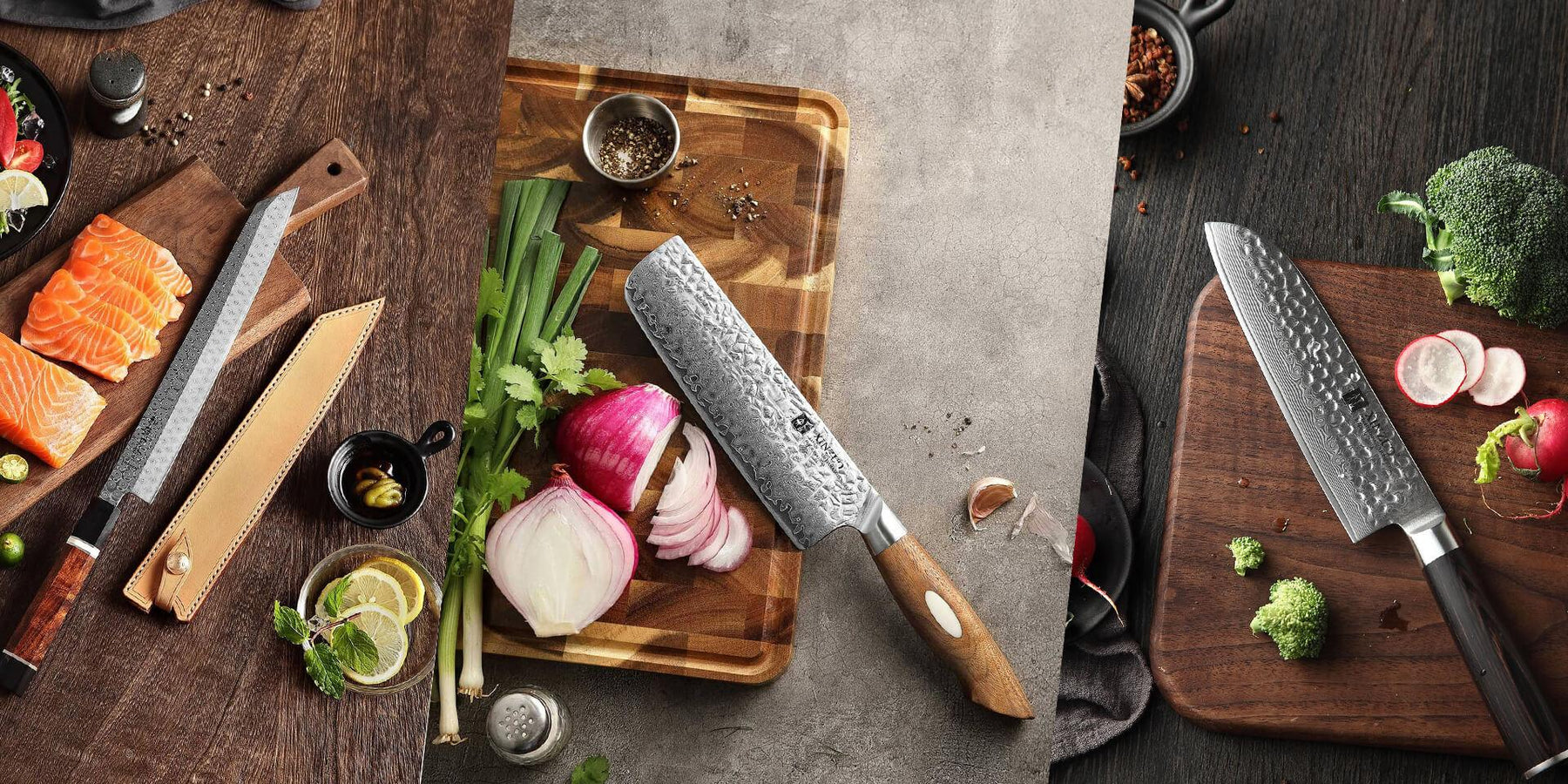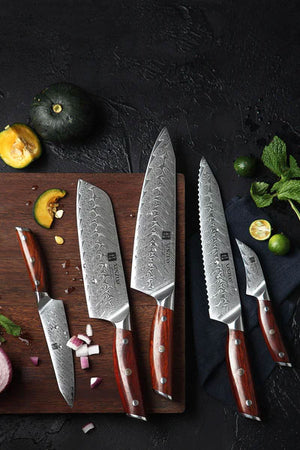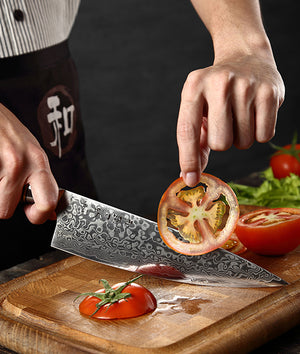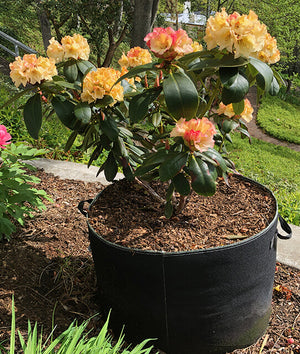
This Vs. That: Santoku Knife Vs. Nakiri Knife Vs. Bunka Knife
In the world of kitchen knives, the santoku knife, nakiri knife, and bunka knife are three knives that stand out for their unique designs and specialized functions. Each of them embodies the meticulous craftsmanship and culinary philosophy of Japan, yet they cater to different needs and cooking styles in the kitchen. So, why are these three knives often thrown into the same category or closely compared?
The santoku knife is often referred to as the workhorse of the kitchen, as an incredibly versatile knife that excels at slicing, dicing, and chopping.
The nakiri knife is slightly more specialized, boasting a straight-edged blade and tailored specifically for precise vegetable preparation – ideal for chefs or home cooks who prioritize a plant-based diet or enjoy making intricate veggie dishes.
Now, the bunka knife is most recognizable due to its distinctive triangular tip, and it offers exceptional control for use in detailed work and fine slicing, bridging the gap between utility and finesse.
There are clearly some major structural and functional differences between these three knives, but on top of all being of Japanese origin and style, there are also plenty of similarities that connect them.
In this article, we’re going to explore it all. We’ll start off by giving you a thorough explanation of the main features and functions of a santoku knife, a nakiri knife, and a bunka knife. And finally, we’ll get right down to the most important similarities and differences between the three.
Whether you’re a seasoned chef or an enthusiastic home cook, understanding the strengths and specialties of these Japanese knives will help you choose the right tool for your kitchen needs. So, stick around while we tell you everything you need to know about santoku, nakiri, and bunka knives.
What is a Santoku Knife?
The first thing most people think when you talk about a santoku knife is versatility, and for good reason. The santoku knife is an all-purpose Japanese kitchen tool whose name actually translates to “three virtues”, reflecting its proficiency in slicing, dicing, and chopping.
Typically, its blade is of medium length and fairly wide with a straightedge and a rounded tip, allowing it to excel in precise, controlled cuts. It boasts a granton edge with dimples which is what reduces food from sticking to it, making it incredibly convenient.
The santoku knife is generally lightweight and well-balanced, making it ideal for cutting vegetables, fish, and other types of meat. For this reason, it’s long been a firm favorite in both professional and home kitchens for its adaptability and ease of use.
What are the Main Features of a Santoku Knife?
We’ve told you that the santoku is versatile and is renowned for its multifunctional capabilities, but what are the distinctive design features that make it the tool that it is?
Here are the main and most important features of the santoku knife:
- Blade Length: Blades are normally short-to-medium length, ranging from five to seven inches long, so even though the santoku knife is often compared to the chef’s knife, it’s far shorter.
- Blade Design: Fairly straight with a very slight curve towards the tip, facilitating precise and controlled cuts.
- Blade Edge: The straight edge is one of the key features of the santoku knife, making it ideal for an up-and-down chopping motion rather than a rocking motion that’s better suited to more curved blades. The blade often has a granton edge (with shallow indentations along the side), reducing friction and preventing food from sticking to the blade.
- Blade Tip: The santoku knife has a rounded tip which makes cutting safer and the knife easier to maneuver.
- Blade Material: Blade material varies, but it’s normally made from high-carbon stainless still, allowing for durability, sharpness, edge retention, and resistance to rust and stains.
- Handle Material: May be made from wood or modern composite materials, depending on preference, budget, and aesthetics.
- Handle Design: Ergonomically designed for a comfortable, secure grip.
- Versatility: The santoku knife excels most at handling vegetables, but its versatility also allows it to work well with meat and fish, making it an all-purpose tool.
What are the Main Functions of a Santoku Knife?
Undoubtedly, the santoku knife is versatile and can be used in many different ways, but let’s have a look at exactly what the main functions of a santoku knife are.
- Slicing: First and foremost, the santoku knife is great at slicing vegetables and fruit, but it’s also good for slicing meats. Its sharp, straight-edged blade allows for clean, even slices making it great for preparing dishes that require uniformity.
- Dicing: Since the knife is quite short and wide, its flat blade is perfect for dicing ingredients. Whether it’s onions, tomatoes, or other vegetables, the design of the santoku knife allows for consistent cuts and precision.
- Chopping: Since the santoku knife has a slightly curved blade, it allows for an efficient chopping motion. It can easily handle things like garlic, herbs, and other small ingredients, but it’s also well-suited to larger veggies like carrots and potatoes. Since the blade is nice and wide, the santoku knife allows for easy transfer of chopped ingredients from the cutting board to the frying pan.
- Crushing: You can use the flat side of the blade to crush nuts or garlic cloves.
- Mincing: The santoku knife is great for mincing ginger, garlic, and herbs due to its sharp edge and pointed tip. Since the knife provides great control, it’s the ideal tool for mincing ingredients to the desired consistency.
- General Preparation: The santoku knife can be used for pretty much any general-purpose kitchen task, like cutting a sandwich in half, slicing cheese, or trimming meat and fish.
What is a Nakiri Knife?
A nakiri knife is a Japanese kitchen knife that is designed specifically for vegetable preparation. It features a straight, rectangular blade that allows for precise, clean cuts with a chopping motion.
The flat edge of the knife ensures that it’s able to make full contact with the cutting board, making it ideal for slicing, dicing, and mincing without having to use a rocking motion.
Normally, the nakiri knife is pretty lightweight, and its design reduces hand fatigue and allows for additional control, allowing for efficient, uniform cuts.
The blade is thin and nice and sharp, making it great for handling delicate produce. Thus, it’s no surprise that the nakiri knife has become a firm favorite among both Japanese and Western cooks who prioritize precision and ease in vegetable preparation.
What are the Main Features of a Nakiri Knife?
So, you know that the nakiri knife is a specialized vegetable knife, known for its efficiency and precision.
Now, let’s take a look at the main features that make the nakiri the knife that it is:
- Blade Design: The blade is straight, rectangular, and flat, making it particularly well suited to chopping and slicing vegetables.
- Blade Length: Normally between five and seven inches long.
- Blade Material: Often made from high-carbon stainless steel, ensuring that the blade is sharp, resistant to corrosion, and has a durable edge that doesn’t need to be sharpened too often.
- Blade Edge: The nakiri knife’s blade has a double-beveled edge that is sharpened on both sides, providing balance and precise cuts. This allows for thin, uniform slices of vegetables and performing detailed tasks like julienning.
- Blade tip: One of the more unusual features, a nakiri knife has a square rather than a pointed tip. The squared-off tip allows for safety and makes it far easier to perform straight, downward cuts, making it less likely that you’ll accidentally slip.
- Handle Design: Designed for comfort and maximum control, the handle of a nakiri knife boasts ergonomic design so that it’s more efficient and enjoyable to use.
- Handle Material: Traditional designs normally use wood, but it can also be made from composite materials.
- Versatility: The nakiri knife is versatile within the scope of working with vegetables. It can make precise, clean cuts, while handling both delicate and tough vegetables alike. This makes it a must-have tool for chefs who enjoy plant-based cooking.
What are the Main Functions of a Nakiri Knife?
As we’ve mentioned, the nakiri knife is specifically crafted for use with vegetables, emphasizing precision and ease of use in Japanese cuisine.
Here are more specific functions of a nakiri knife:
- Slicing: The nakiri knife’s straight, double-edged blade is ideal for slicing vegetables with excellent precision and uniformity. Its flat edge ensures that the knife makes full contact with the cutting board, which allows for smooth, clean slicing without needing to rock the knife.
- Chopping: Designed for chopping vegetables, the nakiri knife excels at cutting through a wide variety of produce with very minimal effort. Its thin blade and sharp edge makes dicing onions, chopping things like carrots and potatoes and working with other vegetables effective and efficient.
- Mincing: The nakiri knife is great for mincing small ingredients like garlic and herbs since the blade is so sharp and precise. The straight edge ensures that you’re able to achieve fine and controlled cuts while cooking.
- Julienning: The nakiri knife’s straight blade and precise cutting edge makes it effective at julienning, especially ingredients like cucumber and bell peppers, allowing you to create thin, even strips for attractive dishes and garnishes.
- General Fruit and Vegetable Prep: In addition to all these specialized tasks, the nakiri knife is versatile enough to be used for a variety of types of vegetable prep. This includes things like peeling, trimming, portioning, and shaping.
What is a Bunka Knife?
Less well known than both the santoku and nakiri knife, the bunka knife is another Japanese kitchen tool that is known for its versatility. However, the bunka knife is different to other knives in that it has a very distinctive triangular tip as well as a fairly flat edge, making it ideal for performing detailed tasks like dicing, chopping, and slicing.
The design of the bunka knife allows for a combination of precision performance and robust chopping, making it suitable for a wide range of ingredients, ranging from vegetables and herbs to fish and meat.
Well-balanced and lightweight, this knife finds the balance between practical versatility and the classic finesse of Japanese craftsmanship, making it a great addition to any chef’s arsenal, both amateur and professional.
What are the Main Features of a Bunka Knife?
But enough about the general, it’s time to get into the specific features of the bunka knife.
- Blade Design: A bunka knife has a fairly short and wide blade with a very distinguishable triangular tip referred to as either a “k-tip” or a “tanto-style” point, enhancing precision and control. The blade has a flatter profile than many other Japanese-style knives.
- Blade Length: Fairly short, between five and seven inches long.
- Blade Edge: Double-beveled edge, sharpened on both sides, providing versatility and balance. The edge is normally angled at about 15 degrees, allowing for precise, clean cuts.
- Blade Tip: The unique triangular tip allows the bunka knife to excel at intricate tasks like scoring meat, fine slicing and having exceptional control and precision.
- Blade Material: The bunka knife is generally known as a high-quality kitchen tool and so it tends to be made from high-carbon stainless steel. This ensures that it’s incredibly sharp, resistant to rust and stains, and it’s durable too. It offers excellent edge retention, so it doesn’t require frequent sharpening.
- Handle Material: It’s often made from traditional materials like wood, providing a classic aesthetic, or composite materials for more of a modern look.
- Handle Design: The shape of the handle is designed with comfort and a secure grip in mind.
- Versatility: The bunka knife is a multifunctional tool that is suitable for a plethora of different kitchen tasks. It can be used for chopping, slicing, dicing, and detail work too, making it a valuable tool in any kitchen.
What are the Main Functions of a Bunka Knife?
As we know, the bunka knife is a versatile Japanese blade that is renowned for its unique design and multifunctional capabilities.
Here are the primary functions of the bunka knife.
- Fine Cutting and Mincing: Due to the combination of its sharp edge and uniquely pointed tip, the bunka knife is a great tool to use for fine cutting and mincing tasks. It will effectively mince herbs, garlic, and other small ingredients finely with accuracy and ease.
- Chopping and Slicing: The broad blade and exceedingly sharp edge of the bunka knife make it adept at slicing and chopping a wide variety of ingredients, including fruit, veggies, fish, and meat. Its versatility allows for a combination of delicate slicing and robust chopping motions.
- Detail Work: The bunka knife boasts exceptional control and precision due to its triangular tip, making it great for intricate tasks like peeling, scoring, and detailed cutting. This is an especially useful trait in Japanese cooking and culinary techniques that tend to require meticulous preparation.
- Multi-Purpose Use: In addition to all its specific uses, the bunka knife is actually great for a variety of more general kitchen tasks, from slicing through thick-skinned vegetables to carving and portioning both raw and cooked meat. Its balanced weight and ergonomically designed handle contribute significantly to comfortable handling and control during use over an extended period of time.
Bunka Knife Vs. Santoku Knife Vs. Nakiri Knife: Similarities
Straight off the bat, there are several features that are shared by the nakiri, santoku, and bunka knife, some pointing to physical attributes and others to design features or origins.
Now that we’ve had a detailed look at the features of each of these knives separately, it’s time to take a deep dive into the things that they share.
- Origin: Arguably the most obvious thing that these three knives share is that they all boast Japanese origin and design features, embodying traditional craftsmanship and design principles that are specifically tailored to Japanese culinary practices.
- Blade Design: While the santoku, nakiri, and bunka knives have very different blades, one thing they have in common is their straight-edged blade. In addition, all three blades are also fairly wide, although the exact dimensions will differ from one to the next.
- Edge: All three knives feature a double-beveled blade edge, with the edge of the santoku and bunka knife sharpened on both sides. This allows for balanced cutting and versatility.
- Versatility: On that note, all three knives are known for their versatility, especially the bunka and santoku knives. The nakiri is also versatile, but its versatility is confined to the world of vegetable prep.
- Blade Material: The santoku, bunka, and nakiri knives are most commonly made from high-carbon stainless steel, or other similar high-quality materials, to ensure durability, sharpness, and resistance to corrosion.
- Handle Design: An ergonomically designed handle is essential for providing a comfortable grip for and precise control for all three knives.
- Practicality: These knives are all highly practical and are able to provide excellent functionality as well as precision and intricacy when needed.
While the santoku, nakiri, and bunka knife are, by no means, identical kitchen tools, they certainly have many things in common. However, in addition to these commonalities are their differences – or rather, unique features.
So, next, we’re going to delve into the differences between the santoku, nakiri, and bunka knife to gain a proper and comprehensive understanding of what sets them apart and why you should have one of each in your kitchen.
Santoku Knife Vs. Nakiri Knife. Vs. Bunka Knife: Differences
While there are many ways in which these knives are similar, there are plenty of factors and functionalities that make each of them distinct.
Here are the main differences between the santoku knife, the nakiri knife, and the bunka knife.
- Blade Shape: Each of the three knives’ blades are slightly different in shape.
- Santoku: Broad blade with a sheep’s foot tip and a slightly curved edge.
- Nakiri: Rectangular edge with a straight edge.
- Bunka: Angular blade with a pointed tip and a slightly curved edge.
- Primary Use: While all three knives are known for being fairly versatile, their primary uses differ slightly.
- Santoku: General-purpose kitchen knife that can provide some precision.
- Nakiri: The primary use of a nakiri knife is for vegetable preparation – it’s not meant to be used for meat or other ingredients.
- Bunka: Also more of a general-purpose kitchen knife, more like a santoku knife, but with added capability for tasks that require finesse and precision.
- Versatility: The santoku and nakiri knife are similar in terms of versatility in that they’re both able to work with a variety of ingredients – from vegetables to fish and meat. However, they differ from the bunka knife in that a bunka knife’s versatility is confined to use with vegetables, and it shouldn’t be used with anything other than vegetables.
- Blade Tip: The tips of these knives’ blades are the most significant means of differentiation between the three. They differ in shape and design due to their intended purpose.
- Santoku: Rounded or slightly curved tip - not pointed.
- Nakiri: A blunt, flat tip.
- Bunka: Often referred to as a k-tip or reverse tanto, a bunka knife has an exceptionally sharp, pointed tip.
- Blade Thickness: When it comes to the thickness of the blade, the santoku and bunka are most similar, with about medium thickness, so to speak. The nakiri, on the other hand, has a far thinner blade.
- Cultural Origin: The most obvious aspect of the cultural origins of these three knives is the fact that they’re from Japan and they’re made in accordance with Japanese design principles. However, they differ a little bit in terms of other influences.
- Santoku: While it originated in Japan, the santoku has become popular in the Western world which has resulted in it being influenced by Western designs. Thus, today, modern santoku knives combine Japanese and Western craftsmanship, achieving fairly broad utility in the kitchen.
- Nakiri: The nakiri knife hasn’t experienced much outside influence and is still deeply rooted in Japanese culinary traditions. Hence, why it’s so specifically tailored to the meticulous handling of vegetables.
- Bunka: The bunka knife is more similar to the santoku in that it reflects a blend of Japanese knife-making traditions, incorporating elements from both traditional Japanese designs and Western traditions.
- Handle and Balance: While they’re all designed with ergonomics in mind, the santoku, nakiri, and bunka do have some differences in terms of specific handle design.
- Santoku: Handle is normally more akin to Western-style handles, allowing for more weight when chopping – hence, more power.
- Nakiri: The handle is normally lighter, more in line with traditional Japanese style, allowing for more delicate work and precision.
- Bunka: The handle of a bunka knife depends on the exact knife in question, especially in terms of balance. Generally speaking, it falls somewhere in between the santoku and nakiri, combining the strengths of both styles.
Final Thoughts on This Vs. That: Bunka Knife Vs. Nakiri Knife Vs. Santoku Knife
Often, we find that knives of Japanese origin are grouped together and conflated due in on small part to where they’re from – or at least, where the origins of their designs are from.
However, we now know that while sharing Japan as a place of origin certainly does add a dimension of commonality, there’s a lot more to take into consideration. Indeed, versatility isn’t universal – one knife may be versatile in every sense of the word, with ability to work with all types of ingredients, while the next may be versatile in the context of use with vegetables.
Thus, hopefully this article has given you all the insight you could possibly need into exactly what santoku, nakiri, and bunka knives are, as well as the ways in which they’re similar as well as where they differ.
With this information, you should be equipped and ready to head on over to our shop and check out our Santoku, Nakiri and Bunka knives.


